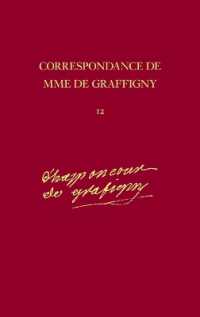- ホーム
- > 洋書
- > 英文書
- > History / World
基本説明
From colonial and postcolonial Africa to pre-Marxist and Stalinist Eastern Europe, this interdisciplinary collection provides new understandings of the utopian/dystopian experience.
Full Description
The concepts of utopia and dystopia have received much historical attention. Utopias have traditionally signified the ideal future: large-scale social, political, ethical, and religious spaces that have yet to be realized. Utopia/Dystopia offers a fresh approach to these ideas. Rather than locate utopias in grandiose programs of future totality, the book treats these concepts as historically grounded categories and examines how individuals and groups throughout time have interpreted utopian visions in their daily present, with an eye toward the future. From colonial and postcolonial Africa to pre-Marxist and Stalinist Eastern Europe, from the social life of fossil fuels to dreams of nuclear power, and from everyday politics in contemporary India to imagined architectures of postwar Britain, this interdisciplinary collection provides new understandings of the utopian/dystopian experience.
The essays look at such issues as imaginary utopian perspectives leading to the 1856-57 Xhosa Cattle Killing in South Africa, the functioning racist utopia behind the Rhodesian independence movement, the utopia of the peaceful atom and its global dissemination in the mid-1950s, the possibilities for an everyday utopia in modern cities, and how the Stalinist purges of the 1930s served as an extension of the utopian/dystopian relationship. The contributors are Dipesh Chakrabarty, Igal Halfin, Fredric Jameson, John Krige, Timothy Mitchell, Aditya Nigam, David Pinder, Marci Shore, Jennifer Wenzel, and Luise White.
Contents
Introduction: Utopia and Dystopia beyond Space and Time 1 PART ONE: ANIMA CHAPTER 1: Fredric Jameson Utopia as Method, or the Uses of the Future 21 CHAPTER 2: Jennifer Wenzel Literacy and Futurity: Millennial Dreaming on the Nineteenth- Century Southern African Frontier 45 CHAPTER 3: Dipesh Chakrabarty Bourgeois Categories Made Global: The Utopian and Actual Lives of Historical Documents in India 73 CHAPTER 4: Luise White The Utopia of Working Phones: Rhodesian Independence and the Place of Race in Decolonization 94 CHAPTER 5: Timothy Mitchell Hydrocarbon Utopia 117 PART TWO: ARTIFICE CHAPTER 6: John Krige Techno- Utopian Dreams, Techno- Political Realities: The Education of Desire for the Peaceful Atom 151 CHAPTER 7: Marci Shore On Cosmopolitanism, the Avant- Garde, and a Lost Innocence of Central Europe 176 CHAPTER 8: David Pinder The Breath of the Possible: Everyday Utopianism and the Street in Modernist Urbanism 203 CHAPTER 9: Igal Halfin Stalinist Confessions in an Age of Terror: Messianic Times at the Leningrad Communist Universities 231 CHAPTER 10: Aditya Nigam The Heterotopias of Dalit Politics: Becoming- Subject and the Consumption Utopia 250 List of Contributors 277 Index 281








